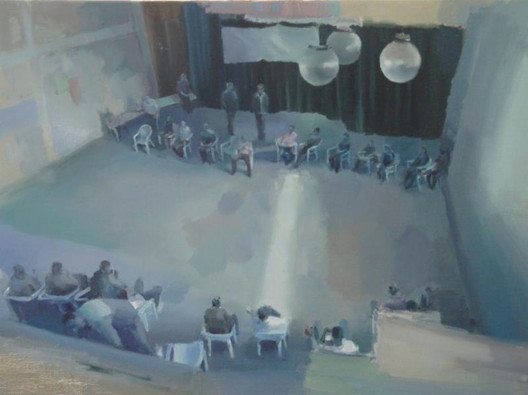In the Land of Tib and Tom

Opening Reception Thursday 15 May, 6 – 8pm • Rubicon Projects at the Octagonal Room City Assembly House
Stephen Brandes, Colin Crotty, Gabhann Dunne, Martin Healy, Eithne Jordan
There are records of a small range of buildings near South William Street, evocatively called “Tib and Tom” where citizens reputedly assembled to practise archery or play nine-pins (skittles) in medieval times. In the Land of Tib and Tom is an exhibition about the real and imagined stories of places. Five artists depict various physical spaces and territories or examine the material traces that linger in buildings over time, as they change form and function.
Very few man-made things seem as stable, as immutable, as a building. We use the term “bricks and mortar” in common parlance to emphasise an unquestionable permanence. Yet the life of any structure is neither fixed nor timeless. Most built things are refined and reshaped by their occupants over time. So, we might see all great buildings as living entities rather than precious, timeless objects, because mankind has revised even the greatest structures as necessary. The Parthenon, that epitome of a ruined temple, was for centuries a working church and then a mosque, and the cathedral of Notre Dame was “restored” to a design that none of its original makers would have recognized.
The ‘Society of Artists in Ireland’ built the Octagonal Room at City Assembly House in 1771; it stands as the first purpose built public art gallery in Britain and Ireland (possibly even in Europe). By 1809 Dublin Corporation had acquired the building, and made considerable changes to the room so that it could serve as City Hall. In the early 1920s the same room housed the Supreme Court of the Irish Republic. Then, in 1952 it became a Civic Museum that remained open until 2003. So, as the Irish Georgian Society settles into City Assembly House they are activating yet another chapter in the story of this extraordinary place. It is their task to unpick the history of the building, removing or restoring elements as appropriate. Whatever changes are applied in future though, the true history, and surely some ghosts and memories will remain as tangible marks, stories and myths.
Stephen Brandes large and detailed drawings and his smaller paintings are a complex series of fabrications that paint a retro-futuristic portrait of Europe. Whether it is himself, or his fictional character whose ‘travelogue’ is the central motif he allows for sub-plots and departures, fed by personal observations, a leaning towards absurdist invention and references to episodes in modern European history.
Colin Crotty culls characters and scenarios from books, documentary film and from the Internet, these are detached from their original meaning and are re-interpreted to create a disjointed narrative. He evokes a fictional scenario, but one that is familiar as it is ingrained in a collective consciousness. Boys and men are gathered together in formal or informal groups and appearing to act either against the status quo or very much at its core.
Gabhann Dunne’s serenely coloured world has a visionary and elegiac quality. Geographic features, figures, buildings and animals emerge from hazy ground, and the artist demonstrates the haunting, lyrical qualities that can be drawn from paint. In stark contrast to the sublime qualities of his paintings, the underlying message explores the fragility, volatility and power of nature and the marks that humans continually make on the landscape.
Martin Healy’s film and photography deal with the issue of belief and its dynamics. He doesn’t present us eerie subjects, but merely the contexts within which these things might happen. He features characters to whom, or by whose hand, we can imagine an unsettling story. So a Healy image immediately flips us into the absent narrative, into the story, the folklore, and the myth.
Eithne Jordan’s interrogation of the urban has been mainly focussed on European cities, often depicted in the light of early dawn and pending darkness. Jordan’s painting is held in a modulated tonality, and yet it is loaded with suggested narratives. Newer works venture indoors; timelines are compressed in the architecture and events as a lean contemporary gallery nestles in what was once clearly a fine period home and a large public building hosts an oversized marble-like urn of almost garish flowers.
Call +353 1 6708055 or 086 8114271 for appointments to visit anytime outside of Public opening hours.
58 South William Street
Dublin 2
